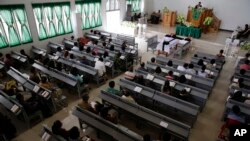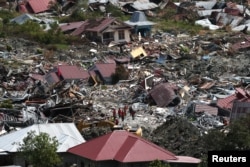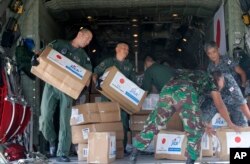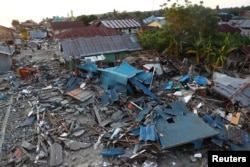Indonesian Christians sought solace Sunday in churches in the city of Palu, hard hit last week by an earthquake and a tsunami that roiled central Sulawesi, killing 1,649 people and seriously injuring some 2,500 people.
Indonesia is the world's most populous Muslim country, but there are Christian communities throughout the archipelago.
During a service held Sunday in front of the Santa Maria Church in Palu, a priest encouraged locals to have faith in God and stay in Palu to rebuild the city.
“If we all leave, then who will welcome those who come here to help us?" Yohanes Salaki asked his congregation, speaking from outside the church as the inside remains unsafe because of damages caused by the earthquake and tsunami.
Palu resident Etna Rorimpande told VOA's Indonesian service that “we have to give ourselves to God, have faith on Him, believe that God will always take care of us.”
Another Palu resident I Nyoman Sarna said that though he is sad and worried about his fate, he think he and his family will stay in the city.
"We have to rebuild our town. Who else will do that?” he said.
The United Nations said in a statement that 113 people remain missing after the twin disasters. About 70,000 people have been displaced.
The U.N. is seeking $50.5 million from the international community to provide relief for the 191,000 Indonesians affected by the natural disasters.
The U.N. announced its plan Friday, saying it developed the program in consultation with its counterparts in the Indonesian government. The initiative outlines the support needed from the international community over the next three months.
United Nations Resident Coordinator in Indonesia, Anita Nirody, said the full scale of the disaster and the recovery needs are becoming clear now that a week has passed. She said the plan not only includes immediate relief but also logistical support needed to deliver aid to those who need it.
Meanwhile, Antara News reports Palu's main market has reopened, under tight security by armed guards. Traders told Indonesian news outlet they fear being raided by looters.
Electricity has been restored to some parts of the city of more than 370,000 residents, which endured the brunt of the disaster. Shops have reopened, a major phone network is back in operation, and a small number of commercial flights have resumed flying in and out of the city's wrecked airport.
The 7.5 magnitude quake triggered a huge tsunami that turned scores of houses and buildings in Palu into mounds of debris. Roads and bridges were washed away, cutting off at least three districts near Palu with a combined population of more than 1 million people.
Indonesia and its 18,000 islands are located along the Pacific Ocean's "Ring of Fire" and frequently are struck by earthquake, volcano and tsunami activity.
In 2004, a 9.1-magnitude earthquake off Sumatra and a subsequent tsunami killed about 230,000 people in 14 Pacific countries. About half of those deaths occurred in Indonesia.
Eva Mazrieva of VOA's Indonesian service contributed to this report.













